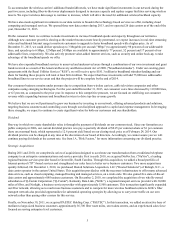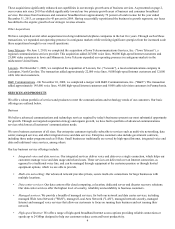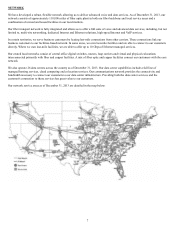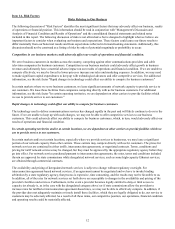Windstream 2013 Annual Report Download - page 111
Download and view the complete annual report
Please find page 111 of the 2013 Windstream annual report below. You can navigate through the pages in the report by either clicking on the pages listed below, or by using the keyword search tool below to find specific information within the annual report.
13
Increases in broadband usage may cause network capacity limitations, resulting in service disruptions or reduced capacity
for customers.
Video streaming services and peer-to-peer file sharing applications use significantly more bandwidth than traditional Internet
activity such as web browsing and email. As utilization rates and availability of these services continue to grow, our high-speed
Internet customers may use much more bandwidth than in the past. If this occurs, we could be required to make significant
capital expenditures to increase network capacity to avoid service disruptions or reduced capacity for customers.
Alternatively, we may choose to implement network management practices to reduce the network capacity available to
bandwidth-intensive activities during certain times in market areas experiencing congestion, and these actions could negatively
affect customer experience and increase customer churn.
While we believe demand for these services may drive high-speed Internet customers to pay for faster broadband speeds, we
may not be able to recover the costs of the necessary network investments. This could result in an adverse impact to our results
of operations and financial condition.
Disruptions and congestion in our networks and infrastructure may cause us to lose customers and incur additional
expenses.
Our customers depend on reliable service over our network. Some of the risks to our network infrastructure include physical
damage to lines, security breaches, capacity limitations, power surges or outages, software defects and disruptions beyond our
control, such as natural disasters and acts of terrorism. From time to time in the ordinary course of business, we will experience
disruptions in our service due to factors such as cable damage, inclement weather and service failures of our third party service
providers. Additionally, we could face disruptions due to capacity limitations as a result of changes in our customers' high-
speed Internet usage patterns. These patterns have changed in recent years, for example through the increased usage of video,
resulting in a significant increase in the utilization of our network.
We could experience more significant disruptions in the future. Disruptions may cause interruptions in service or reduced
capacity for customers, either of which could cause us to lose customers or incur additional expenses or capital expenditures.
Such results could adversely affect our results of operations and financial condition.
Disruptions in our data centers could cause service interruptions for customers using advanced data services.
Many of our advanced data products are supported by our data center infrastructure, including offerings such as colocation
services, cloud computing, managed services and disaster recovery services. Risks to our data center infrastructure include, but
are not limited to, natural disasters, security breaches, power surges or outages, or acts of terrorism.
If a disruption occurs in one of our data centers, our customers could lose access to information critical to running their
businesses, which could result in a loss of customers. We may also incur significant operating or capital expenditures to restore
service. As a result, disruptions could affect our results of operations and financial condition.
We cannot assure you we will continue paying dividends at the current rate.
Our board of directors maintains a current dividend practice for the payment of quarterly cash dividends at a rate of $0.25 per
share of common stock. This practice can be changed at any time at the discretion of the board of directors, and our common
stockholders should be aware that they have no contractual or other legal right to dividends. In addition, the other risk factors
described in this section could materially reduce the cash available from operations or significantly increase our capital
expenditure requirements, and these outcomes could cause funds not to be available when needed in an amount sufficient to
support our current dividend practice.
The amount of dividends that we may distribute is also limited by restricted payment and leverage covenants in our credit
facilities and indentures, and, potentially, the terms of any future indebtedness that we may incur. The amount of dividends that
we may distribute is also subject to restrictions under Delaware law. If our board of directors were to adopt a change in our
current dividend practice that results in a reduction in the amount of dividends, such change could have a material and adverse
effect on the market price of our common stock.
























